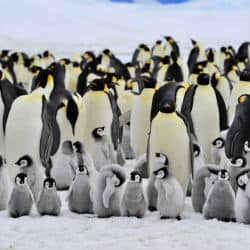Emperor Penguins Can Be Too Hot In Freezing Antarctic Winter

One of nature’s great survivors are emperor penguins because they have the ability to endure the Antarctic winters which are frigid cold and where temperatures fall to as low as -20 °C or below. In order to avoid freezing to death, emperor penguins huddle together in groups that are tightly packed to conserve heat and provide shelter from the intensely cold wind.
Huddles can get too hot
According to the latest research it would appear that these huddles can perform their task of keeping emperor penguins warm rather to well. The science is easy to understand, the penguins on the outside of the huddle are directly hit by icy wind chill of Antarctica. On the inside the complete opposite is happening, the penguins there are getting too hot so after some time they require a little room to cool off.
Hot penguins break apart huddles
In a new paper in the journal Animal Behaviour, researchers say that penguins looking to reduce their body heat actually break huddles apart. Inside the huddles, the penguins lose very little heat at all. The little heat that is lost comes from either their heads or from breathing the frigid air. This means they are often in warm temperatures of as high as 37.5 °C, which is far warmer than they would like.
“As a consequence, birds face the paradox that in a cold physical environment they sometimes need to dissipate excess heat,” the team report.
The research team closely analysed penguin huddles and found that huddles are constantly changing both in response to overheated penguins and in response to the outside temperature. Prior to the latest study it was assumes that penguin huddles were static structures which has now proven to not be the case.
The process keeps repeating
Andre Ancel of the French National Centre for Scientific Research in Strasbourg, lead author of the report says that birds join huddles when they need to be warmed, however when their body temperature reaches positive values, they break from the huddle. Once they are on the outside again, they clean their feathers and eat fresh snow and when they feel cold again they repeat the process.



